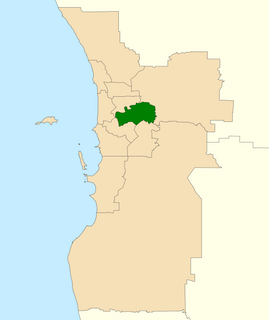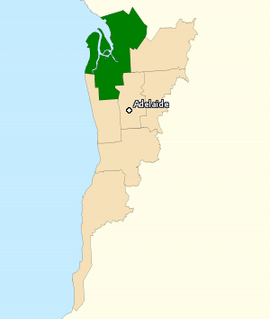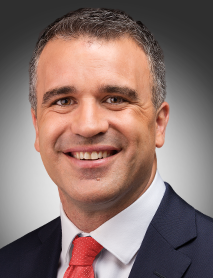Related Research Articles

The House of Assembly, or lower house, is one of the two chambers of the Parliament of South Australia. The other is the Legislative Council. It sits in Parliament House in the state capital, Adelaide.

The Division of Swan is an Australian electoral division located in Western Australia.

The Division of Boothby is an Australian federal electoral division in South Australia. The division was one of the seven established when the former Division of South Australia was redistributed on 2 October 1903 and is named after William Boothby (1829–1903), the Returning Officer for the first federal election.

The Division of Hindmarsh is an Australian Electoral Division in South Australia covering the western suburbs of Adelaide. The division was one of the seven established when the former Division of South Australia was split on 2 October 1903, and was first contested at the 1903 election, though on vastly different boundaries. The Division is named after Sir John Hindmarsh, who was Governor of South Australia from 1836 to 1838. The 78 km² seat extends from the coast in the west to South Road in the east, covering the suburbs of Ascot Park, Brooklyn Park, Edwardstown, Fulham, Glenelg, Grange, Henley Beach, Kidman Park, Kurralta Park, Morphettville, Plympton, Richmond, Semaphore Park, Torrensville, West Beach and West Lakes. The Adelaide International Airport is centrally located in the electorate, making noise pollution a prominent local issue, besides the aged care needs of the relatively elderly population − the seat has one of Australia's highest proportions of citizens over the age of 65. Progressive boundary redistributions over many decades transformed Hindmarsh from a safe Labor seat in to a marginal seat often won by the government of the day.

The Division of Mayo is an Australian electoral division located to the east and south of Adelaide, South Australia. Created in the state redistribution of 3 September 1984, the division is named after Helen Mayo, a social activist and the first woman elected to an Australian University Council. The 9,315 km² rural seat covers an area from the Barossa Valley in the north to Cape Jervis in the south. Taking in the Adelaide Hills, Fleurieu Peninsula and Kangaroo Island regions, its largest population centre is Mount Barker. Its other population centres are Aldgate, Bridgewater, Littlehampton, McLaren Vale, Nairne, Stirling, Strathalbyn and Victor Harbor, and its smaller localities include American River, Ashbourne, Balhannah, Brukunga, Carrickalinga, Charleston, Cherry Gardens, Clarendon, Crafers, Cudlee Creek, Currency Creek, Delamere, Echunga, Forreston, Goolwa, Gumeracha, Hahndorf, Houghton, Inglewood, Kersbrook, Kingscote, Langhorne Creek, Lobethal, Macclesfield, McLaren Flat, Meadows, Middleton, Milang, Mount Compass, Mount Pleasant, Mount Torrens, Mylor, Myponga, Normanville, Norton Summit, Oakbank, Penneshaw, Piccadilly, Port Elliot, Second Valley, Springton, Summertown, Uraidla, Willunga, Woodchester, Woodside, Yankalilla, and parts of Birdwood, Old Noarlunga and Upper Sturt.

The Division of Sturt is an Australian electoral division in South Australia. It was proclaimed at the South Australian redistribution of 11 May 1949. Sturt was named for Captain Charles Sturt, nineteenth century explorer.
The Division of Hawker was an Australian Electoral Division in South Australia. The division was created in 1969 and abolished in 1993. It was named for Charles Hawker, who was a federal MP 1929–38. It was located in the southern suburbs of Adelaide and took in the suburbs of Ascot Park, Clovelly Park, Edwardstown, Glenelg, Goodwood and Morphettville. Hawker was located between the seats of Hindmarsh and Kingston.

The Division of Port Adelaide was an Australian electoral division in the state of South Australia. The 181 km² seat extended from St Kilda in the north to Grange Road and Findon in the south with part of Salisbury to the east. Suburbs included Alberton, Beverley, Birkenhead, Cheltenham, Findon, Kilkenny, Largs Bay, Mansfield Park, North Haven, Ottoway, Parafield Gardens, Paralowie, Pennington, Port Adelaide, Queenstown, Rosewater, Salisbury Downs, Semaphore, Woodville, West Croydon, and part of Seaton. The seat also included Torrens Island and Garden Island. Port Adelaide was abolished in 2019, after a redistribution triggered by a change in representation entitlement which saw South Australia's seats in the House of Representatives reduced to ten.

The Division of Wakefield was an Australian electoral division in the state of South Australia. The seat was a hybrid rural-urban electorate that stretched from Salisbury in the outer northern suburbs of Adelaide at the south of the seat right through to the Clare Valley at the north of the seat, 135 km from Adelaide. It included the suburbs of Elizabeth, Craigmore, Munno Para, and part of Salisbury, and the towns of Balaklava, Clare, Freeling, Gawler, Kapunda, Mallala, Riverton, Tarlee, Virginia, Williamstown, and part of Port Wakefield.

Newland is a single-member electoral district for the South Australian House of Assembly. It is named after pioneer Simpson Newland, a prominent figure in nineteenth-century South Australia. It is a 69.3 km² suburban electorate in north-eastern Adelaide, taking in the suburbs of Banksia Park, Fairview Park, Forreston, Hope Valley, Houghton, Humbug Scrub, Inglewood, Kersbrook, Lower Hermitage, Millbrook, Paracombe, Ridgehaven, Sampson Flat, St Agnes, Tea Tree Gully, Upper Hermitage, Vista and Yatala Vale as well as parts of Chain of Ponds and Modbury.
Norwood is a former electoral district of the House of Assembly in the Australian state of South Australia. It was a 14.2 km² inner-urban electorate in Adelaide and was named after the inner-eastern suburb of Norwood. In its final configuration, the seat also included the suburbs of Beulah Park, College Park, Evandale, Firle, Hackney, Joslin, Kent Town, Marden, Maylands, Payneham South, Royston Park, St Morris, St Peters, Stepney, Trinity Gardens and Vale Park, as well as parts of Kensington, Klemzig and Payneham.
The Playmander was a gerrymandering system, a pro-rural electoral malapportionment in the Australian state of South Australia, which was introduced by the incumbent Liberal and Country League (LCL) government in 1936, and remained in place for 32 years until 1968.

The 2014 South Australian state election elected members to the 53rd Parliament of South Australia on 15 March 2014, to fill all 47 seats in the House of Assembly and 11 of 22 seats in the Legislative Council. The 12-year-incumbent Australian Labor Party (SA) government, led by Premier Jay Weatherill, won its fourth consecutive four-year term in government, a record 16 years of Labor government, defeating the opposition Liberal Party of Australia (SA), led by Opposition Leader Steven Marshall.
Baudin was an electoral district of the House of Assembly in the Australian state of South Australia from 1977 to 1993. It was in the southern suburbs of Adelaide. In 1977, the polling places were: Christie Downs, Christies Beach, Hackham, Hackham East, Hallett Cove, Moana, Noarlunga, O'Sullivan Beach, Port Noarlunga and Seaford.
Semaphore was an electoral district of the House of Assembly in the Australian state of South Australia from 1938 to 1993.

Dunstan is a single-member electoral district for the South Australian House of Assembly, covering the inner eastern suburbs of Beulah Park, College Park, Evandale, Firle, Hackney, Joslin, Kensington, Kensington Park, Kensington Gardens, Marden, Maylands, Norwood, Payneham, Payneham South, Royston Park, St Morris, St Peters, Stepney, and Trinity Gardens.
Todd was an electoral district of the House of Assembly in the Australian state of South Australia from 1977 to 1993. The new seat of Torrens absorbed much of the abolished seat of Todd at the 1991 redistribution.

The 2018 South Australian state election to elect members to the 54th Parliament of South Australia was held on 17 March 2018. All 47 seats in the House of Assembly or lower house, whose members were elected at the 2014 election, and 11 of 22 seats in the Legislative Council or upper house, last filled at the 2010 election, were contested. The record-16-year-incumbent Australian Labor Party (SA) government led by Premier Jay Weatherill was seeking a fifth four-year term, but was defeated by the opposition Liberal Party of Australia (SA), led by Opposition Leader Steven Marshall. Nick Xenophon's new SA Best party unsuccessfully sought to obtain the balance of power.

The 2022 South Australian state election was held on 19 March 2022 to elect members to the 55th Parliament of South Australia. All 47 seats in the House of Assembly, and half the seats in the Legislative Council were up for re-election.
Central District No. 2 was an electoral district for the South Australian Legislative Council from 1913 until 1975. It was created by the Constitution Act Further Amendment Act 1913, which divided the Central District into two districts, each to elect four members. The size of the Legislative Council was to remain at 18 until the next general election, and increase to 20 by adding a new member for each of the two new districts. From its creation until the next general election, Central District No. 2 comprised the extant Assembly electoral district of Torrens. The act also redrew the Assembly electoral districts from the next election. From then, Central District No. 2 would comprise the new Assembly districts of Sturt and East Torrens.
References
- ↑ "Statistical Record of the Legislature, 1836 - 2007" (PDF). Parliament of South Australia. Archived from the original (PDF) on 11 March 2019. Retrieved 19 January 2014.
- ↑ "Appointment of Polling Places". Commonwealth of Australia Gazette. Australian Government Publishing Service. 4 November 1977. p. 35. Retrieved 21 April 2019.